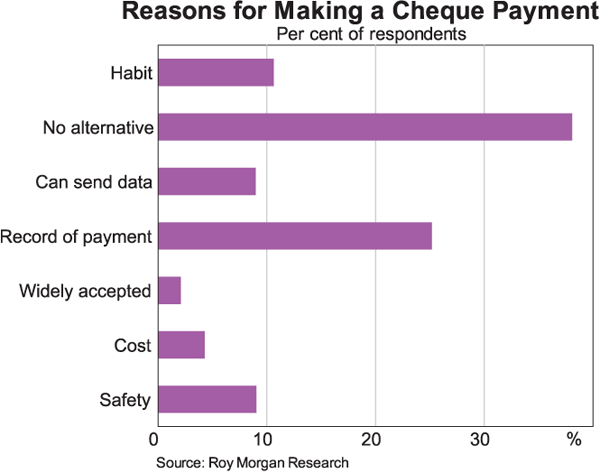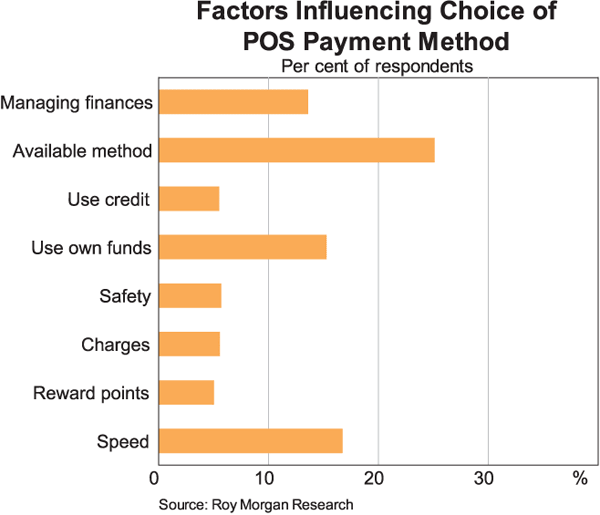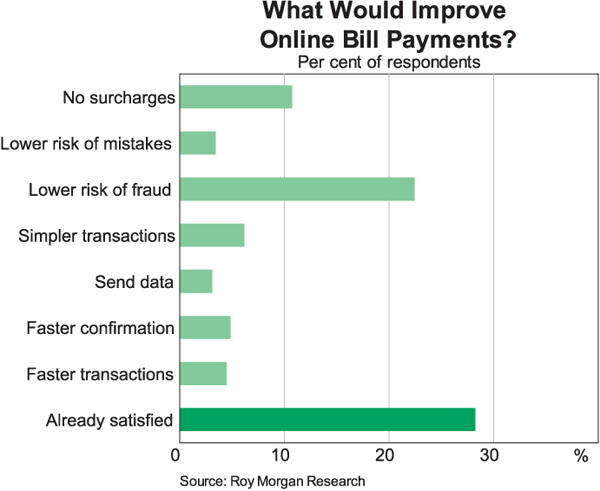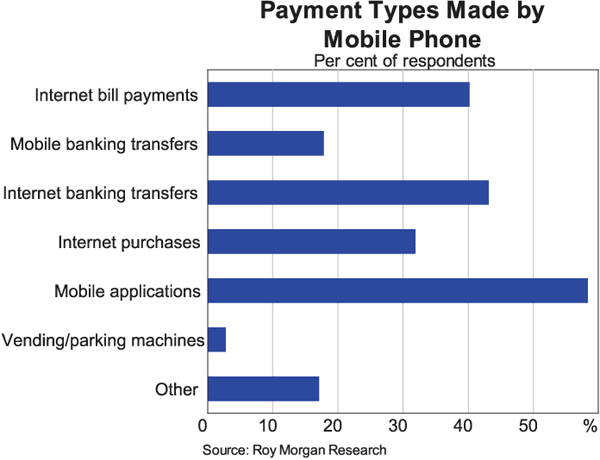Speech The Reserve Bank's Strategic Review of Payments Innovation
Thanks very much for the opportunity to speak here today.
This is a conference that is all about innovation in the payments system. I know that the businesses represented here would all have their own approaches to innovation, and some of those will have been on display in the various presentations.
But we also have a common interest in ensuring that the system as a whole can develop as efficiently and cost effectively as possible. I've been asked to talk today about the Reserve Bank's role in that.
As you know, the RBA launched a strategic review of payments innovation in July last year.
In talking about the review, the first thing I want to stress is that we see this as very much a co-operative project. When we announced the review, the first thing we did was to call for an initial round of consultations, both with industry and with any other interested parties that wanted to contribute. We've had a good response to that. We have had discussions (sometimes multiple discussions) with most of the main market players; we have talked to people working in particular fields of payments innovation; and we have had some discussions with end-users of the payments system.
Based on what we learn from that, we'll be putting together a more detailed document for release around mid year, which will then be the basis for a more formal round of consultation in the second half of the year. We hope to have a final report ready by around year-end.
I start with that description of the process because I want to emphasise that this is very much something that we're doing with the involvement of the interested parties. It's not just a top-down exercise.
The process still has some way to go, and I'm not going to pre-empt any conclusions today. But I want to use my time to report on what we've found so far, how we're approaching the task, and the issues we're likely to be focusing on from here.[1]
Economic Case for Co-ordination in the Industry
The first question that might be asked is: why do we need a strategic review in this area, and why now?
I have to say that there's no particular trigger for having it now, but we do believe it's a good general principle that these matters should be kept under periodic review. The RBA, through its Payments System Board, has a mandate to promote payments system efficiency. A good deal of our work in that area has focused on the efficiency of price signals. The Bank has taken the view that, where price signals are distorted for some reason, there is a case for using its regulatory powers to correct them.
But efficiency also covers operational aspects of the system, including things like the cost, speed and reliability of payment services and, the subject of today's talk, its capacity to innovate.
When we think about innovation in a network setting like this one, it's useful to distinguish between two types: proprietary innovations, where the benefits are localised to the business that's doing the innovating (and to the customers of that business); and system-wide innovations, where the benefit accrues to users of the system as a whole.
It's reasonable to expect that service providers will do a good job with the first kind of innovation. In fact we see examples of that kind of development all the time. For example, we are currently seeing financial institutions exploring new ways to use mobile devices for payment purposes, including for making person-to-person payments using the existing infrastructure. Similarly a major bank is promoting the ability of its systems to update customer account information in real time.
But it's in the second type of innovation that there is the more serious potential for inefficiency, or for under-investment. That might happen through a lack of co-ordination among industry participants, or through a lack of incentive for individual providers to participate in system-wide improvements. We're not starting with the presumption that that's the case – only that it could be.
As a regulator, we recognise that our approach to these questions has to be quite different from the way we approach other cases for regulatory involvement. The RBA has significant powers, as you know, to designate payments systems and to set standards. But we're well aware that you can't regulate innovation into being. That's not the intention. As far as possible we'll be aiming to work with industry, looking at whether there are areas where more co-ordination is needed, and assisting with that where we usefully can.
Objectives of an Efficient Payments System
In taking on a project like this, it's useful to start off with some idea of the characteristics we're looking to promote in an efficient payments system. Here are some of the main ones:
Timeliness
Not all payments are time-critical, but users of the system should at least have options available that give recipients timely access to their funds and allow timely confirmation to both parties.
Accessibility
It's desirable that everyone who needs to make and receive payments should have ready access to the payments system.
Ease of use
It goes without saying that systems that are easier to use are preferable to those that are more cumbersome. But this is not only an issue of convenience. Systems that require manual entry of account and transaction details are prone to errors that can be costly to correct and can discourage use. That is one reason why payment cards are so popular – because most of the need for manual entry is removed. The need to know a recipient's account details is another challenge for many payment systems. One of our oldest payment methods – the cheque – deals with that by only requiring the recipient's name, with the recipient doing the rest. The challenge for electronic payment systems is to replicate or improve upon that sort of convenience.
Ease of integration with other processes
Payments are rarely made in complete isolation. Typically they are made as part of a process that requires reconciliation and recording of information by the parties involved. It's desirable that payment systems should be able to integrate efficiently with these processes. A key example here is the capacity of payment systems to carry additional reconciliation information with the payment.
Safety and reliability
End users of a payment system need to have confidence that the system will be available when needed and that payments will reach the intended recipient at the time promised. They also need to be confident that the system is secure, so that using it will not expose them to future losses as a result of information being fraudulently obtained. Some of these problems can be addressed by system participants guaranteeing payments, but good system design is a more fundamental solution.
Low and transparent costs
Some would say that this has been a preoccupation of the RBA over the past decade. If two systems perform exactly the same function, we should of course prefer the cheaper one. But the reality is more complicated than that. Each system typically has different attributes from every other system, and so end users need to make choices as to which one most cost-effectively meets their needs. That means that costs need to be transparent, so that those choices can be well-informed.
These, then, are some of the qualities that we might regard as desirable in an efficient payments system. You can probably think of a few more. But having given a list like that, we also need to recognise that there are trade-offs. Investment in innovation comes at a cost, borne initially by industry but ultimately by the customer. So in conducting the review, we'll need to be talking with providers and users of payment services about both the costs and benefits they see in different approaches.
Payments Use Study
One important source of information about that from the end-user perspective will be the Reserve Bank's latest Payments Use Study. This was a study of around 1,200 households conducted in October/November last year, updating an earlier study from 2007. Participants were asked to keep a diary of their payments over a one-week period and were also asked about their attitudes to newer payment methods not covered in the diary, like contactless or mobile payments.[2]
We expect to publish a detailed analysis of the findings later in the year, but I can give you a few preliminary results today that throw some useful light on the innovation review.
Results from the diary data suggest two main conclusions on payment patterns.
-
First, the broad patterns of payments behaviour observed in the 2007 study still
hold.
- Cash remains the most widely used payment instrument in Australia and the dominant instrument for low-value payments.
- Cards are the dominant payment method for mid-value payments (between $50 and $500), with the use of credit cards growing relative to debit cards as the transaction value increases.
- BPAY and internet banking are used frequently for bill payments and high-value transactions.
-
Second, payment patterns have nonetheless evolved to some degree in the three years
since the initial study. In particular:
- Use of cash has declined somewhat. This is especially noticeable in cash's share of the value of what we would call traditional payment methods – down from around 40 per cent to 30 per cent of the value of those payments;
- Debit cards appear to have been substituted for cash, with scheme debit and EFTPOS transactions both gaining share.
Those are the broad results on the pattern of actual payments made. A questionnaire conducted at the end of the diary study also gives some additional information as to how people think about different payment methods. Here are just a few samples.
First, on the use of cheques: fewer than 40 per cent of consumers reported making a payment by cheque in the past year. Of those 40 per cent, this graph shows the main reason that they chose to use a cheque (Graph 1).

The most common reason was that people felt that they had no alternative for the type of payment they were making. That is significant, given that one of the issues being considered both by the industry and the current review is the scope for phasing out cheque use.
Next, in order to understand the attributes that people value for point of sale payments, we asked people what factors influence their choice of payment method at the checkout.
Perhaps not surprisingly, the most important factor was what they happen to be carrying with them at the time. Beyond that, the main factor cited in determining how people pay is the speed of processing the transaction, followed by the ability to use their own funds and the ease of managing finances (Graph 2). The importance of speed is significant because it helps explain why people continue to use cash for small value transactions, and it also indicates that the current push towards contactless cards might be quite important for many consumers.

Given the increasing importance of internet payments over recent years, we also spent some time exploring consumers' use of, and attitudes towards, different types of online payments.
First of all, we found what seems to be quite high adoption of online payments. Around 90 per cent of respondents had access to the internet, either at home or at work. Of those, about 80 per cent reported having made an online purchase and almost 60 per cent reported an online transfer of funds to a family member or friend. A surprisingly high 60 per cent of people with internet access said they pay most of their bills online.
We also tried to find out what things prevent people from making even greater use of online payments (Graph 3). The graph we have here shows the answers for online bill payments, but we also collected responses for online purchases and transfers.

First of all, to explain the large bar at the bottom: we were asking people what would make them happier to use online bill payments, but what we found was that more than a quarter of respondents were already satisfied and didn't think they could be improved. Beyond that, by far the biggest factor preventing people from making more use of online bill payments is the risk of fraud.
This was even more marked for online purchases, where around half of respondents identified risk of fraud as a factor discouraging greater use. In fact, the level of satisfaction is lower for online purchases overall than for online bill payments and transfers. Probably this reflects a lower degree of comfort with online purchases using methods like credit cards and PayPal, compared to making bill payments using BPAY and internet banking transfers.
Adoption of the other two new waves of payments technology – contactless payments and mobile payments – is much lower than online payments. Only around 3 per cent of survey respondents had made a contactless payment in the last month. Less than 10 per cent of respondents had ever made mobile payments. Where they had, the main purpose was for phone-related purchases such as ringtones or games (Graph 4). Most of the other mobile payments made were effectively internet payments made using a smartphone.

In short, the survey doesn't seem to point to any major dissatisfaction with payments services in Australia, but it sheds some light on why payment-use patterns are as they are, and some possible areas of improvement that can be looked at further. We'll be publishing a fuller analysis of these results later in the year.
Results of the Initial Consultations
As I said earlier, we've had significant interest shown by a wide range of industry and other players in response to our initial request for comments. A number of interested parties have provided us with written submissions, and many more have made themselves available for informal discussions with RBA staff. I expect we'll receive a more substantial body of submissions during the second round of consultation in the second half of the year.
The consultations to date have highlighted a number of quite specific issues that are going to be worth considering as part of the Strategic Review. I'll briefly go through a cross section of those, but this is by no means exhaustive. I also note that many of these issues are not new, and are already being thought about by the industry.
Transmission of data with payments
Successful integration of payments systems into other processes requires that sufficient information travel with the payment to allow proper reconciliation. A business owner making payment to a supplier might wish to convey information, not just on the invoice number, but (for example) on which items on that invoice are being paid and why. An employer making a payment to a super fund needs to be able to provide information on the relevant employee accounts, the amounts of each payment and even the type of payment. Even an individual sending money to a friend or relative might simply want to attach a personal message to that payment. At the moment, the choices are largely either:
- to limit the additional information to the 18 characters permitted by the direct entry system;
- to separate the payment from the information and put in place a process to bring them back together at a later stage;
- or to pay by cheque attached to the information source.
The question for the review will be whether this is likely to represent a significant shortcoming in our payments system in the years ahead? And if it is, what is the best means of addressing it and how should that be achieved?
Timeliness and ease of addressing payments
There are times when we really need payments to be made quickly. The classic example is government emergency payments. Most government payments to individuals can be made perfectly adequately by the direct entry system. But in an emergency, the availability of funds the next day might not be sufficient. In recent times many such payments have been made using the RTGS system, even though this is a long way away from that system's intended use. Even then, the speed can vary significantly depending on the systems of the recipient bank.
A related issue is the ease of addressing payments to individuals. As I said before, writing someone's name on a cheque is relatively straightforward, but directing an electronic payment can be much more difficult. For most people this currently involves entering BSB and account number details into an internet banking package. This of course means having to obtain those details from the recipient (who mightn't even remember them) and then keying in all the details correctly. This probably does not meet the ‘ease of use’ test.
Overseas experience might give us some guide on this issue. For example we know that the United States is putting a lot of emphasis on pre-paid cards for government payments, although this no doubt in part reflects the country's high number of unbanked welfare recipients. On the other side of the Atlantic, the UK's Faster Payments system provides a closely watched example of improving the timeliness of payments.
Of course the Strategic Review is intended to be forward looking. So we should be asking, not just about the demand for these sorts of improvements, but also the extent to which likely developments could meet that demand over the next few years. These questions might also lead to a focus on the constraints that the major banks' own internal systems place on their capacity to provide faster payments.
The decline of cheques
The number of cheques written in Australia has been declining by an average of 9 per cent per year over the past decade. Over time, this is adding to unit costs. The result is that cheques, which were already an expensive form of payment, are becoming increasingly so. Nonetheless, our consultations have reinforced the fact that cheque use remains entrenched in certain areas because it meets a number of specific needs. I have already mentioned several of these areas, including the ease with which cheques can be addressed to others and accompanied by additional information. They are also very suitable in face-to-face exchanges and for providing an element of financial control.
Any decision to move away from cheques (and I'm not pre-judging the issue) will be dependent on the industry's capacity to develop suitable and equally convenient electronic alternatives. I'm aware that the industry is separately looking at this, but it seems appropriate that the Payments System Board should also be considering how the decline in cheques is addressed from a public interest perspective.
In addition to these issues, there are a number of other things that we expect will come into consideration, whether as stand-alone topics or interwoven with other discussions. These include:
- Mobile payments. There is already a lot of interest and activity in this area. The Board's main interest will be in determining whether there are impediments to the development of mobile payments, for example in relation to standards.
- Standards themselves cut across many areas of payments, including messaging, device and security standards. Their design and application can have significant implications for efficiency and for innovation. The increasingly global nature of commerce suggests that adoption of internationally compatible standards will be very important for maintaining a world class payments system.
- Electronic purse systems – that is, general purpose, prepaid, and typically contactless cards like Oyster in London and Octopus in Hong Kong. Where these have been successful, there tends to be significant interdependency with electronic transport ticketing systems, which have been slow to develop here. The question once again is whether there is a significant impediment to development of these systems in Australia, given the already high use of payment cards.
- Security. Our survey results suggest that concerns about fraud are impeding the take-up of online payments. This may also become an issue for mobile payments. A question for the Strategic Review is whether there is a need for increased co-ordination and co-operation on fraud issues.
Finally it's worth saying that, more important than any of these individual issues is the overarching environment for innovation. I made the distinction at the start between proprietary and system-wide innovations. Our focus in this review is very much on the second one of those. This is the area that needs the most careful attention from a public-interest perspective, because it requires a degree of co-operation amongst industry competitors that might not otherwise happen efficiently. It also requires that the interests of end-users and non-incumbents be taken into account.
The next stage of the review will be seeking views on those issues, whether there are better ways to address them and whether there are new areas where a co-operative approach is needed. An inevitable component of that is what role the Reserve Bank should play, given that it has often stepped in, in one way or another, when a solely industry-based approach has not proved feasible.
Conclusion
What I've outlined today is a big agenda, and I expect it will keep us very busy in the time ahead.
As I said at the start, this review is very much a co-operative effort. I and my staff appreciate the assistance we've had already, both from industry and from payment users. And we look forward to continuing to work with you to promote best-practice innovation in the Australian payments system.
Endnotes
I thank Darren Flood for his assistance in preparing this speech. [*]
To clarify the scope of the exercise, this review is about low-value payments (in other words, retail and relatively small business-to-business payments). It's not about the high-value wholesale payments system, which is subject to its own regular assessment process. [1]
The study was conducted by Roy Morgan Research on behalf of the RBA, and is largely a repeat of the payments diary study undertaken as part of the 2007/08 review of the card payments reforms. It asked around 1,200 study participants in late October and early November 2010 to carry a payments diary with them for a week and record details of all their payments and cash withdrawals. Details recorded included: the payment method used; the size of the transaction; the merchant category and the payment channel (for example, in person, internet, phone, or mail). [2]
